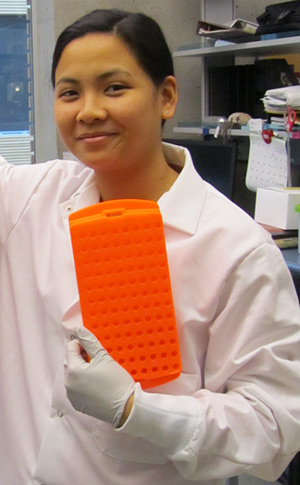 By Tara Fernandez, Postdoctoral Fellow at Conway Lab, CBR
By Tara Fernandez, Postdoctoral Fellow at Conway Lab, CBR
Losing the ability to see a loved one’s face clearly, or use a computer or cell phone is probably unthinkable to most of us. However, this is the frightening reality for those suffering from age-related macular degeneration (AMD), the leading cause of vision loss among those over 50 in developed countries. This progressive degenerative disease of the eye affects about 8 million individuals in the United States alone and has a devastating effect on the quality of life for most sufferers.
The macula is the most sensitive region of the retina, consisting of specialized cells required for high-definition central vision. Damage to the macula results in distortions or darkened patches appearing within the central field of view. This makes everyday activities frustratingly impossible. To make matters worse, very little is known about the pathophysiology of AMD, with suitable treatments only available for people with a small sub-type of this condition.
Interestingly, excess complement activation and oxidative stress have been identified as potential mechanisms underlying this disease. Linnette Ocariza, a Masters Student in the Conway Lab at the CBR, has a strong interest in the molecular regulators of the complement system and has spent the last 2 years uncovering more about their role in AMD progression.
As part of her research, together with others in the Conway Lab, Linnette discovered a fascinating association between AMD and a molecule found in bacteria and commonly used as a food preservative, which may hold the key to arresting the progression of the disease. Polyphosphate (PolyP) is an inorganic polymer that has been in the spotlight due to its potent inhibitory effects on the complement system. Abundantly found in platelets, PolyP has been shown to modulate several aspects of coagulation and inflammation. As a naturally occurring compound, PolyP is therefore a promising candidate for combating AMD, by suppressing the immune system and limiting damage to the eye by oxidative stress.
Linnette tested this theory in a variety of cell and mouse experimental models. These included a state-of-the-art technique she learned for creating controlled lesions on the retinas of mice in order to simulate AMD damage and identify the effects of potential remedies. She found that PolyP not only significantly interfered with the terminal pathway of complement, but also acted as an antioxidant, thus dampening the main routes of AMD progression.
Looking back on the highs and lows of her Masters experience, Linnette spoke on some of the challenges and victories associated with her research. Long hours and failed experiments paid off after making some important breakthroughs in her work, particularly with her in vivo studies. She strongly believed that being part of a supportive team and engaging with the wider CBR community helped her to grow as a researcher and learn from the experiences of her peers. Being given the opportunity to mentor Summer Students, present at CBR seminars and travel to conferences have also equipped her with valuable academic and life skills for the future. Eager to pursue a career in Medicine, Linnette has the following advice for the next generation of researchers – be resilient and patient; and get involved with scientific activities outside the lab. She is hopeful that her discovery may one day lead to a ray of hope for those battling AMD by providing them with a safe and effective treatment for their disease.



